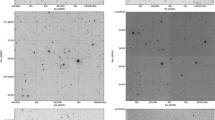Abstract
The system of open clusters is an excellent probe of the structure and evolution of the galactic disk. Their spatial, size, age and mass distributions provide valuable information on the cluster formation process. Present day astronomy is rich in data, and hence in this work, we attempt to build up a comprehensive statistical study of star clusters. This study is based on available catalogues, both homogeneous and inhomogeneous, to provide some useful insights on the evolutionary history of the system of open clusters and consequently, the galaxy. We find that the optimum size of a cluster for its survival is 3–4 pc. We also find that there exists a simple linear relationship between the age and the mean linear diameters of clusters and also with normalised reddening. Using the catalogues based on Gaia DR2 and other catalogs, we find, that the system of open clusters provides valuable clues to our understanding of the evolution of the galaxy. This system can be partitioned by k-means to get clusters in a statistical sense, which indicates possible cluster formation in the galaxy at different galactocentric distances and with different parameters. These suggests a combination of the scenarios of overall halo collapse and accretion to explain the formation of the disk of the galaxy. This method is proposed to be used for the study of external galaxies using catalogues of extragalactic clusters as it works well with the clusters of the Milky Way.
Access this chapter
Tax calculation will be finalised at checkout
Purchases are for personal use only
Similar content being viewed by others
Notes
- 1.
\(p \le 0.05\) implies a confidence level larger than 95 %.
- 2.
clusters in italics refers to clusters in the statistical sense and not physical star clusters.
References
Allen, C.W.: Astrophysical Quantities, 3rd edn. Athlone, London (1976)
Bell, E.F., et al.: The accretion origin of the Milky Way’s stellar halo. 680, 295–311 (2008). https://doi.org/10.1086/588032
Bonatto, C., Bica, E.: Detailed analysis of open clusters: a mass function break and evidence of a fundamental plane. 437, 483–500 (2005). https://doi.org/10.1051/0004-6361:20042516
Cantat-Gaudin, T., et al.: A Gaia DR2 view of the open cluster population in the Milky Way. 618, A93 (2018). https://doi.org/10.1051/0004-6361/201833476
Dias, W.S., Alessi, B.S., Moitinho, A., Lépine, J.R.D.: New catalogue of optically visible open clusters and candidates. 389, 871–873 (2002). https://doi.org/10.1051/0004-6361:20020668
Friel, E.D.: The old open clusters of the Milky Way. 33, 381–414 (1995). https://doi.org/10.1146/annurev.aa.33.090195.002121
Gaia Collaboration, et al.: The Gaia mission. 595, A1 (2016). https://doi.org/10.1051/0004-6361/201629272
Hasan, P.: Gaia. Resonance 24(4), 433–444 (2019). https://doi.org/10.1007/s12045-019-0796-2
Janes, K.A., Phelps, R.L.: The galactic system of old star clusters: the development of the galactic disk. 108, 1773–1785 (1994). https://doi.org/10.1086/117192
Janes, K.A., Tilley, C., Lynga, G.: Properties of the open cluster system. 95, 771–784 (1988). https://doi.org/10.1086/114676
Joshi, Y.C.: Interstellar extinction towards open clusters and Galactic structure. 362, 1259–1266 (2005). https://doi.org/10.1111/j.1365-2966.2005.09391.x
Kharchenko, N.V., Piskunov, A.E.: The population of open clusters of the Galactic disc. Astron. Astrophys. Trans. 25, 177–183 (2006). https://doi.org/10.1080/10556790600916863
Kharchenko, N.V., Piskunov, A.E., Röser, S., Schilbach, E., Scholz, R.D.: Astrophysical parameters of Galactic open clusters. 438, 1163–1173 (2005). https://doi.org/10.1051/0004-6361:20042523
Kharchenko, N.V., Piskunov, A.E., Schilbach, E., Röser, S., Scholz, R.D.: Global survey of star clusters in the Milky Way. II. The catalogue of basic parameters. 558, A53 (2013). https://doi.org/10.1051/0004-6361/201322302
Loktin, A.V., Gerasimenko, T.P., Malysheva, L.K.: The catalogue of open cluster parameters-second version. Astron. Astrophys. Trans. 20, 607–633 (2001). https://doi.org/10.1080/10556790108221134
Lynga, G.: Open clusters in our Galaxy. Astron. Astrophys. 109, 213–222 (1982)
MacQueen, J.: Some methods for classification and analysis of multivariate observations. In: Le Cam, L.M., Neyman, J. (eds.) Proceedings of the Fifth Berkeley Symposium on Mathematical Statistics and Probability, Berkeley, Califonia. University of California Press, vol. 1, pp. 281–297 (1967)
Majewski, S.R.: Galactic structure surveys and the evolution of the Milky Way. 31, 575–638 (1993). https://doi.org/10.1146/annurev.aa.31.090193.003043
Mermilliod, J.C.: The database for galactic open clusters (BDA). In: Egret, D., Albrecht, M.A. (eds.) On-Line Data in Astronomy, pp. 127\(-\)+ (1995). ISBN 0-7923-3659-3. Astrophysics and Space Science Library, Vol. 203, p. 127 (Sep 1995)
Paunzen, E., Netopil, M.: On the current status of open-cluster parameters. 371, 1641–1647 (2006). https://doi.org/10.1111/j.1365-2966.2006.10783.x
Piatti, A.E., Clariá, J.J.: The apparent overdensity of open clusters in the Canis Major overdensity. 390, L54–L58 (2008). https://doi.org/10.1111/j.1745-3933.2008.00536.x
R Core Team: R: A Language and Environment for Statistical Computing. R Foundation for Statistical Computing, Vienna, Austria (2013). http://www.R-project.org/
Spitzer, L.J.: Distribution of galactic clusters. 127, 17\(-\)+ (1958). https://doi.org/10.1086/146435
Tadross, A.L.: Morphological analysis of open clusters’ propertiesI. Properties’ estimations. New Astron. 6, 293–306 (2001). https://doi.org/10.1016/S1384-1076(01)00061-6
van den Bergh, S.: Diameters of open star clusters. 131, 1559–1564 (2006). https://doi.org/10.1086/499532
van den Bergh, S., McClure, R.D.: Galactic distribution of the oldest open clusters. 88, 360–362 (1980)
Wielen, R.: The age distribution and total lifetimes of galactic clusters. 13, 309–322 (1971)
Wielen, R.: The diffusion of stellar orbits derived from the observed age-dependence of the velocity dispersion. Astron. Astrophys. 60, 263–275 (1977)
Acknowledgements
The authors also thank Hargopal Vajjha and C R Rao for comments and suggestions in statistics. Virtual observatory tools like VOSTAT and Topcoat have been used in the analysis.
Author information
Authors and Affiliations
Corresponding author
Editor information
Editors and Affiliations
Rights and permissions
Copyright information
© 2020 Springer Nature Singapore Pte Ltd.
About this paper
Cite this paper
Hasan, P., Hasan, S.N. (2020). The System of Open Star Clusters Revisited. In: Saha, S., Nagaraj, N., Tripathi, S. (eds) Modeling, Machine Learning and Astronomy. MMLA 2019. Communications in Computer and Information Science, vol 1290. Springer, Singapore. https://doi.org/10.1007/978-981-33-6463-9_11
Download citation
DOI: https://doi.org/10.1007/978-981-33-6463-9_11
Published:
Publisher Name: Springer, Singapore
Print ISBN: 978-981-33-6462-2
Online ISBN: 978-981-33-6463-9
eBook Packages: Computer ScienceComputer Science (R0)




